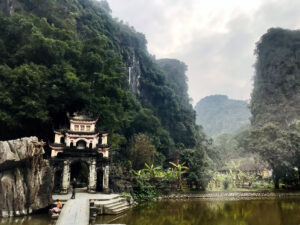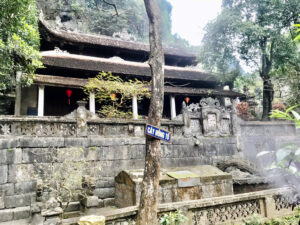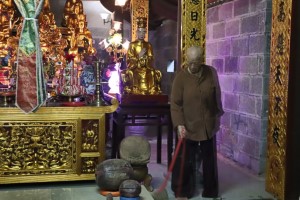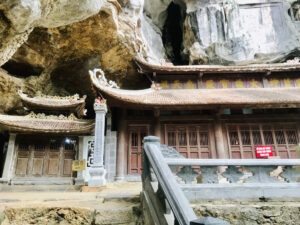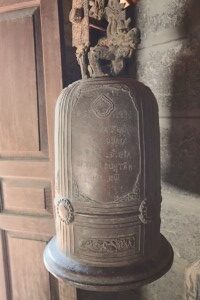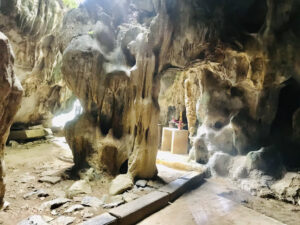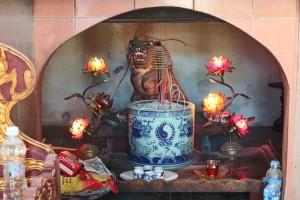Ancient and almost forgotten artisans built Bích Động Pagoda and its accompanying gardens, and they have mesmerized visitors for a millennia. Generations of caretakers have preserved and added to the site for centuries, enhancing its famed elegance and serenity through their ingenuity in complementing the exquisite natural landscape. A recent visit confirmed that the work continues today.
As both national treasures and part of the Trang An global natural heritage complex, Bích Động Pagoda and Tam Coc attract the attention of most domestic and foreign tourists, even if many don’t recognize the names.
The Academy award winning film Indochine includes many scenes filmed at Bích Động Pagoda, which helped introduce it to a new international audience. More recently, the Hollywood blockbuster Kong: Skull Island brought international fame to Tam Coc and Trang An in 2016.
Bích Động radiates a timeless beauty that draws visitors in and makes them linger in this serene and revered Buddhist refuge.
To reach the pagoda grounds, visitors cross a small green stone bridge that spans the adjacent lagoons, where lotus flowers float gently on the surface. As they pass through the “Triple Gate” entrance, the atmosphere instantly transports them into a world shaped by ancient stone, wood, and myth.
To emphasize its Buddhist origins, the site features a statue of Quan Âm—also known as Guanyin, the Buddhist Goddess of Mercy and Compassion—positioned above the entrance. After stepping through the gate, visitors walk along a narrow footpath that leads them to the main pagoda area.
A Serene Setting
The architects of the pagoda enhanced the natural landscape of the mountains and trees surrounding the area, with an orchard situated to the right of the walkway. Scenic all year round, the winter season is particularly stunning. Then the persimmon trees shed their leaves to reveal ripe, juicy fruit that glitter like ink red gems against a backdrop of the weathered stone and wooden pagodas surrounded by thick tropical forest.
The green mountains and woods blend with the blue-white sky to create the inspiration for countless ink wash paintings. Visitors are invited to relax, take a deep breath of cool air and expel all thoughts and suffering. For Bich Dong Pagoda is a place dedicated to the serenity of the Buddha, a place to find healing for weary hearts.
Legend has it that the pagoda was originally named “Bạch Ngọc Thạch Sơn Đồng,” which roughly translates as ” white jade pagoda hidden in the forest”. In 1774, Lord Trịnh Sâm (1739-1782) arrived at the pagoda and changed its name to Bích Động, meaning “The Emerald Pagoda.”. Though the reasoning is unclear, it is assumed Lord Trinh was referring to the hidden forest location. Regardless of name changes, for centuries Bích Động has been a destination for many prominent Vietnamese and overseas mendicants, poets, authors and artists seeking inspiration and spiritual peace.
The Two Monks
Bích Động Pagoda was initially constructed in 1428 but disappeared into the jungle in the turmoil of war and unrest. It was rediscovered in the early 18th century by two traveling monks spreading the word of Buddha throughout the countryside. Arriving at Bích Động, they were captivated by the beauty and serenity of the mountainous retreat. Their wandering ended as they decided to stay to renovate and expand the pagoda.
The two monks spent the following years seeking donations and assistance from far and wide.. Due to the successful capitol raising, they were able to add two more structures, as well as design the intricate gardens to complement the high mountain landscape. Thanks to their efforts, Bích Động is now a truly gorgeous collection of three temples and gradens. Hạ (lower), Trung (middle), and Thượng (upper) pagodas remain in the stunning location and are meticulously maintained.by the continuing population of resident monks.
On arrival, visitors proceed first to the Ha Pagoda, the lower temple with five rooms made from wooden and stone pillars. This pagoda worships both Buddha and reveres the Buddhist monks who guided the creation of this renowned temple. It also contains a stone tablet (stele) that records the names of benefactors who contributed to the pagoda’s construction.
Upon entering the pagoda area, there are kiosks of local elderly ladies selling souvenirs, candles and temple goods. This area also serves as the main administration area, not part of the temple proper. The stalls are handy for purchasing incense, mementos or perhaps a cool drink. As mentioned, the surrounding garden is also home to carefully maintained,ancient trees that are centuries old. Wizened persimmon and jack fruit trees provide a perfect place of contemplation prior to entering the pagoda itself.
Ha and Trung Pagoda
At the heart of the Ha pagoda campus are two moss covered, carved stone lions. Complimenting these temple guards is a dragon statue, its face pointing upwards towards the moon, indicating spiritual submission to the Buddha’s strength and authority. Inside are many Buddhist sculptures such as Avalokitesvara Bodhisattva, the Infant Buddha Shakyamuni, Amida Buddha, and other deities arranged on the main altar.
From the ceiling hangs a horizontal lacquered board engraved with Sino-Vietnamese characters which states that a pure mind is in the reach of us all. The roof of the pagoda has two layers, curled at the end like white birds extending their wings and flying over the beautiful green rice fields.
The journey from Ha Pagoda to Trung (middle) Pagoda is a 120 step s-shaped stone pathway that passes through the stupas, and overlooks the panoramic landscape below. Looking back, the roof of the Ha pagoda peeps out from behind the Malayan Banyan tree canopy that grows on the down slope and create a lush green curtain separating the two levels.
The Trung Pagoda is located in the center of the complex and is half Pagoda (chùa) and half cave (Hang). Making use of the cave’s topography, the pagoda has three compartments. The main room has an altar for Sakyamuni Buddha (Buddhism’s founder) encircled by nine dragons. The two outer sculptures are for worship of the Manjushri Bodhisattva and Samantabhadra Bodhisattva.
Hang Toi
The ceiling here is the living rock of the cave’s dome. On the left side of Trung Pagoda, there is a small entrance with a narrow passage leading to the “Dark Cave” (Hang Toi). A little stairway of 21 steps continues on to the main expanse of the Dark Cave. Be aware that in inclement weather, the entrance is extremely slippery and the cave itself regularly floods. At such times, the monks will close the cave to visitors.
Although relatively small compared to many Ninh Binh cave systems, the Hang Toi is famous for the limestone stalactites that festoon the ceiling in a variety of fantastical shapes. The grotto itself is for worship of both Buddha and Mau Thuong Ngan, the Mother forest goddess of Vietnamese folk religion.
The large 18th-century copper bell is said to alleviate the pain of injustice when rung three times. Although modern caretakers have installed auxiliary lights, people still call it the “Dark Cave” for a reason. Guests who want to fully appreciate the pagoda’s grandeur should bring a flashlight to see everything more clearly.
Thượng Pagoda
After passing through the Dark cave, 40 stone stairs lead upward to the Thượng Pagoda. Arriving at the summit, visitors have a panoramic view of the temple complex and its surrounding mountains.
The large Frangipani trees in front of the pagoda when in-season produce fragrant blossoms that celebrate the “spring hue”. In the afternoon light of spring the scent adds to the rich atmosphere of the brocaded mountains and rivers slowly concealing themselves in the encroaching dusk.

Inside Thượng Pagoda there is a statue of Bodhisattva Guanyin ( Quán Thế Âm in Vietnamese) . On the left side is a stele recording the pagoda’s renovations and donations. Outside, there are two modest shrines with statues of gods and Buddha in the Vietnamese spiritual tradition.
Feng shui practitioners describe Bích Động as resembling a lotus center. The five surrounding mountains symbolize five petals that encircle the lotus bud. Visitors often marvel at the large jagged stones with sharp surfaces behind the pagoda and notice the ancient frangipani trees as their roots pierce the earth in search of nutrients.
The vision of the tangled roots spreading across the ground, clinging to the deep green mountains and refusing to let go despite the wind on all sides symbolizes that in spite of the hundreds of years of hardships, the spirit of Bích Động still remains steadfast and strong.
Xuyên Thủy Cave
Underneath Bích Động mountain lies a dark and often flooded cave known as Xuyên Thủy Động. This cave is around 350m long and crescent moon-shaped from east to west. Often tourists will explore this cave as part of the Tam Coc-Bich Động boat trip – but check first!
Bích Động pagoda is truly magnificent in its charming and poetic setting as much for its distinctive religious architectural beauty. A national treasure, it is asid to reflect the cultural and historical motifs of the Vietnamese nation.
Travel Tips
Visitors can take a 1-2 kilometers walk from Tam Coc wharf to the pagoda. Alternatively, take a Tam Coc boat trip that includes the Pagoda. It is important to be careful of scammers who may try to sell entrance tickets.Visiting Bích Động is free. That said, it is polite to leave a small donation, but that is entirely up to the visitor.
If visitors choose to self-drive or ride, parking fees will apply. For motorcycles, parking is 10k VN and bicycles cost 5-10k VND. Arriving by car, parking fees will be around 40-50k VND. Many of the cafe and restaurants now the entrance to the pagoda provide “free” parking- if you buy something!. At all times remember that a taxi or Grab from Tam Coc only costs around 15-20,000 VND each way.
note: this is a major religious site for Vietnamese people. Dress respectfully, take off shoes and hats when accessing prayer areas and keep the noise down.

